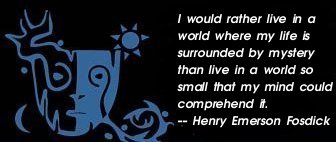|

Excerpt from Psyche and Matter
"Time: Rhythm and Repose"
by Marie-Louise von Franz
© 1992 And used by arrangement with Shambhala Publications, Inc. Boston, MA
Time as a Deity and the Stream of Events
 Time is one of the great archetypal experiences of man, and has eluded all our attempts towards a completely rational explanation.1 No wonder that it was originally looked upon as a Deity, even as a form of manifestation of the Supreme Deity, from which it flows like a river of life. Only in modern Western physics has time become part of a mathematical framework, which we use with our conscious mind to describe physical events. The mind of primitive man made less distinction than ours between outer and inner, material and psychic, experiences. Primitive man lived in a stream of inner and outer events which brought along a different cluster of co-existing events at every moment, and thus constantly changed, quantitatively and qualitatively.
Time is one of the great archetypal experiences of man, and has eluded all our attempts towards a completely rational explanation.1 No wonder that it was originally looked upon as a Deity, even as a form of manifestation of the Supreme Deity, from which it flows like a river of life. Only in modern Western physics has time become part of a mathematical framework, which we use with our conscious mind to describe physical events. The mind of primitive man made less distinction than ours between outer and inner, material and psychic, experiences. Primitive man lived in a stream of inner and outer events which brought along a different cluster of co-existing events at every moment, and thus constantly changed, quantitatively and qualitatively.
 Even our seemingly self-evident concepts of past, present, and future do not seem to be universal. The Hopi Indians, for instance, do not possess them in their language. Their universe has two basic aspects: that which is manifest and thus more "objective" and that which is beginning to manifest and is more "subjective." Concrete objects are manifest and in this way already belong to the past; inner images, representations, expectations and feelings are "subjective," on their way to manifestation, and thus bend more towards the future. The present is that razor-edge where something stops beginning to manifest (is already past) or is on the verge of beginning to manifest. There is no continuing flow of time for the Hopi, but a multiplicity of subtly distinguished moments. The creator of all this is 'a'ne'himu, a "Powerful Something" which is a kind of cosmic breath.2 Children, too, do not at once live in our communal clock time. They have been shown to perceive rhythm, velocity, and frequency long before they begin to adapt to our ordinary notion of time.3 Even our seemingly self-evident concepts of past, present, and future do not seem to be universal. The Hopi Indians, for instance, do not possess them in their language. Their universe has two basic aspects: that which is manifest and thus more "objective" and that which is beginning to manifest and is more "subjective." Concrete objects are manifest and in this way already belong to the past; inner images, representations, expectations and feelings are "subjective," on their way to manifestation, and thus bend more towards the future. The present is that razor-edge where something stops beginning to manifest (is already past) or is on the verge of beginning to manifest. There is no continuing flow of time for the Hopi, but a multiplicity of subtly distinguished moments. The creator of all this is 'a'ne'himu, a "Powerful Something" which is a kind of cosmic breath.2 Children, too, do not at once live in our communal clock time. They have been shown to perceive rhythm, velocity, and frequency long before they begin to adapt to our ordinary notion of time.3
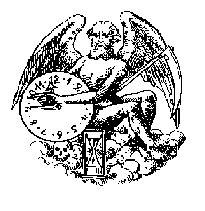 In man's original point of view, time was life itself and its divine mystery. This remains so in the ancient Greek notion of time. The Greeks actually identified time with the divine river Oceanos, which surrounded the earth in a circle and which also encompassed the universe in the form of a circular stream or a tail-eating serpent with the Zodiac on its back. It was also called Chronos (Time) and later identified with Kronos, the father of Zeus, and also with the god Aion. In man's original point of view, time was life itself and its divine mystery. This remains so in the ancient Greek notion of time. The Greeks actually identified time with the divine river Oceanos, which surrounded the earth in a circle and which also encompassed the universe in the form of a circular stream or a tail-eating serpent with the Zodiac on its back. It was also called Chronos (Time) and later identified with Kronos, the father of Zeus, and also with the god Aion.
Aion originally denoted the vital fluid in living beings, and thus their life span and allotted fate. This fluid continued to exist after death in the form of a snake.4 It was a "generative substance," as was all water on earth and especially Oceanos-Chronos, the creator and destoyer of everything. 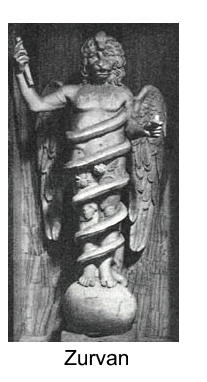 The philosopher Pherekydes taught that the basic substance of the universe was time (Chronos), from which fire, air, and water were produced. 5 Oceanos was also a kind of primal World Soul.6 The philosopher Pherekydes taught that the basic substance of the universe was time (Chronos), from which fire, air, and water were produced. 5 Oceanos was also a kind of primal World Soul.6
In Hellenistic times, Aion Chronos was identified with the old Persian time-god Zurvan.7 The ancient Persians discerned two aspects of this supreme deity: Zurvan akarana, Infinite Time, and Zurvan daregho-chvadhata, Time of a Long Dominion. The latter was the cause of decay and death, and was sometimes even identified wih Ahriman, the principle of evil. The Orphic and Mithraic circles of late antiquity identified Zurvan, in both his opposed aspects at once, with their Aion.8 A text invokes Aion with the following words:
-
- I greet thee, thou that fillest the whole structure of the air, spirit that stretchest from heaven to earth... and to the confines of the abyss... spirit that also penetratest myself and leavest me again. Thou, the servant of the rays of the sun, that enlightenest the world... a great circular mysterious form of the universe, heavenly spirit, ethereal spirit, earthy, fiery, windy, light... dark spirit, that shinest like a star... Lord, god of the Aions... Ruler of everything.9
Aion, the god of time, is here clearly an image of the dynamic aspect of existence, of what we might call today a principle of psychophysical energy. All opposites — change and duration, even good and evil, life and death — are included in this cosmic principle.
This Aion was also sometimes identified with the sun god, who is obviously the great indicator of time measures. The initiate prays to him: "O Lord, who with thy spirit bindest the fiery keys of the fourfold belt...fire-walker, creator of light, fire-breather, with fiery courage...Aion, lord of light,...open the doors to me."10
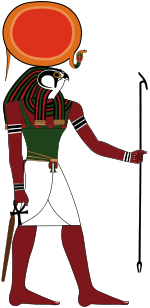 This god inherited many aspects of the Egyptian sun god, Ra, who was the ruler of time. Every hour of the day and night this supreme deity changed his shape: he rose, for instance, as a scarab, and descended into the underworld as a crocodile; in the moment of his resurrection after midnight he assumed the shape of a double lion, Routi, "Yesterday and Tomorrow."11 Osiris, the resurrected human being who became a god, also says of himself: "I am Yesterday, Today and Tomorrow." 12 He lives in the "House of Eternity" or a "House of Millions of Years." This god inherited many aspects of the Egyptian sun god, Ra, who was the ruler of time. Every hour of the day and night this supreme deity changed his shape: he rose, for instance, as a scarab, and descended into the underworld as a crocodile; in the moment of his resurrection after midnight he assumed the shape of a double lion, Routi, "Yesterday and Tomorrow."11 Osiris, the resurrected human being who became a god, also says of himself: "I am Yesterday, Today and Tomorrow." 12 He lives in the "House of Eternity" or a "House of Millions of Years."
Besides the sun god, the ancient Egyptians personified unending time also as a separate god, Heh, who has the Ankh, the symbol of life, suspended at his right arm. As in Greece, the snake in Egypt was also connected with time. It symbolized life and health, and each individual was protected by a "lifetime snake," which was a daemon of time and of survival after death.13
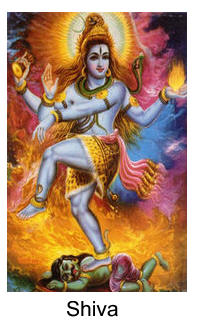 This same archetypal symbolism of time, as the godhead and also as an unending stream of life and death, can be found in India. In the Bhagavad Gíta (3rd or 4th century B.C.) the god Krishna reveals himself to Arjuna in his terrible form. He sees in him all other gods together: "I see a figure infinite, wherein all figures blend to countless bodies, arms and eyes." In a great stream they disappear into his jaws of flaming fire, entering them with hurried step.14 Then Vishnu says: "Know I am Time that makes the worlds perish, when ripe and come to bring them destruction." Not only Vishnu but also Shiva represents time. He symbolizes "the energy of the universe increasingly creating and sustaining the forms in which he manifests himself."15 Shiva is called Maha Kala, "Great time," or Kala Rudra, "All-Devouring Time." His Shakti, or active energy, appears in its destructive form personified in the terrible goddess Kali, who is Time, for Kali was interpreted as the feminine form of Kala, which means Time, the black-blue color, and death. This same archetypal symbolism of time, as the godhead and also as an unending stream of life and death, can be found in India. In the Bhagavad Gíta (3rd or 4th century B.C.) the god Krishna reveals himself to Arjuna in his terrible form. He sees in him all other gods together: "I see a figure infinite, wherein all figures blend to countless bodies, arms and eyes." In a great stream they disappear into his jaws of flaming fire, entering them with hurried step.14 Then Vishnu says: "Know I am Time that makes the worlds perish, when ripe and come to bring them destruction." Not only Vishnu but also Shiva represents time. He symbolizes "the energy of the universe increasingly creating and sustaining the forms in which he manifests himself."15 Shiva is called Maha Kala, "Great time," or Kala Rudra, "All-Devouring Time." His Shakti, or active energy, appears in its destructive form personified in the terrible goddess Kali, who is Time, for Kali was interpreted as the feminine form of Kala, which means Time, the black-blue color, and death.
The mystical philosophy of Hinduism looks upon this world as unreal; time is especially what deceives the unenlightened soul into believing exclusively in his own self-conscious being and the reality of outer things. But in fact this perishable, changing world is a kind of illusion: "Verily for him who knows this [for the enlightened man]... the sun never rises nor sets. For him it is day forever" (Chandogya Upanishad III, 11.3).
This "eternal day" is God himself. Similarly, a North American Delaware Indian described a vision he had of God: He saw "a great man clothed with the day, the most radiant day he had ever seen, a day of many years, even of eternal duration. The whole world was spread over Him, so that one could see the earth and all things on earth in Him."
Notes:
- Cf. J. T. Fraser (ed.), The Voices of Time (New York: Braziller, 1966), and J.T. Fraser and N. Lawrence (eds.), The Study of Time: Proceedings of the First (Second, Third) Conference of the International Society for the Study of Time, 3 vols. (Heidelberg & New York, 1972, 1975, 1979). Cf. also J.T. Fraser (ed.), Of Time, Passion and Knowledge (New York: Braziller, 1975); G.J. Whitrow, The National Philosophy of Time (London & Edinburgh, 1961; J.B. Priestly in Man and Time (London: Aldus, 1964); F. Le Lionnais, "Le Temps," Série Science no. 2 de l'Encyclopédie essentielle (Paris, 1959).
- Cf. B. L. Whorf, Sprache, Denken, Wirklichkeit (Hamburg, 1963) p. 80.
- Cf. Jean Piaget, Le Développement de la notion du temps chez l'enfant (Paris, 1964)
- Cf. R. B. Onians, The Origins of European Thought (Cambridge, 1954), p. 206.
- Ibid., p. 248.
- Ibid., p. 249.
- Cf. S.G.F. Brandon, History, Time and Deity (Manchester, 1965), and "The Deification of Time," in The Study of Time I. p. 376.
- Cf. C.A. Campbell, Mithraic Iconography (New York, 1968).
- K. Preisendenz, Papyri graecae magicae (Stuttgart: Teubner, 1973), vol. 1, p. 111.
- Ibid., p.93.
- Cf. C. de Wit, Le Róle et le sens du lion dans l'Egypte ancienne (Leiden, 1951), P. 72; Marie-Louise von Franz, Number and Time (Evanston, Ill., 1974) pp. 92ff.
- Cf. Brandon, "The Deification of Time," in The Study of Time I, p. 372.
- Cf. H. Bonnet, Reallexikon der ägyptischen Religionsgeschichte Berlin, 1952), pp. 682, 257ff, 833-34.
- The Bhagavad Gita trans. A.W. Ryder (Chicago: University of Chicago Press, 1929), chap. 11.
- Cf. Heinrich Zimmer, Myths and Symbols in Indian Art and Civilization (New York, 1962), pp. 148-51.
 Editor's Notes: Editor's Notes:
The consideration of "Time" takes us straight into the heart of this Great Mystery in which we find ourselves, into the consideration of the nature of "reality"... and illusion.
You have now read Bill Bridges' marvelous essay About Time, and so you know that we will be considering aspects of Time throughout the issues of this year's Mythic Passages.
You have also just read the first several pages of a chapter of Marie - Louise von Franz' Psyche and Matter (published in 1988). Two chapters of this book, "Time: Rhythm and Repose" and "The Psychological Experience of Time" are for me among the clearest and most comprehensive of writings about time. In these chapters, she examines the ways the members of many cultures view the human experience of time. A related von Franz book which I recommend is Number and Time: Reflections Leading Toward a Unification of Depth Psychology and Physics.
Marie-Louise von Franz (1915 - 1998) worked closely with Carl Jung for 27 years, from the time she met him until his death. A Swiss Jungian psychotherapist, she also was a founder of the C. G. Jung Institute in Zurich. She was a scholar and the author of many books related to psychology, including numerous works on myth. Known for her work with dreams, she was the subject of a film, The Way of the Dream. Filmed interviews with von Franz are available, and information on these may be found at the media library of the C.G.Jung Society of Atlanta.
In this excerpt from Psyche and Matter, von Franz begins her discussion of various time concepts (Hopi, Greek, Egyptian, Hindu and Delaware). I find especially interesting her discussion of the Hopi concept of two temporal forms (instead of "past, present and future"). These two temporal forms are that which is manifest and that which is beginning to manifest, "...with a multiplicity of subtly distinguished moments" in which intensity becomes very important.
Following these two pages (from the total eighty pages), von Franz next discusses Chinese thought, saying that time belongs to the masculine Yang principle and space belongs to the feminine Yin principle. She says, "These two together manifest the Tao, the secret law which governs the cosmos...Time seen in this way, is the 'means of making actual what is potential.'" She quotes Granet who says that Yin and Yang are not static but alternating cosmic rhythms, and she discusses the I Ching in detail.
Then, taking us through Maya and Aztec beliefs, she tells us the most frequently used word for "time" in Mayan languages means "sun" and "day," and that the religious thought of the Maya includes a double - headed snake with one head meaning life and one head meaning death. (Remember the "lifetime snake" from Egypt, our own snake in the Judaeo - Christian creation story, and from Hindu thought, the great divine snake Ananta who carries the whole universe as his body provides a bed for Vishnu?)
Von Franz then discusses the Judaeo-Christian belief that God is outside time, "having created time together with the universe." Her sub-headings for the first article are: Time as a Deity and the Stream of Events; Cyclical and Linear Time; Rhythm and Periodicity; Necessity, Chance, and Synchronicity; Transcending Time. She includes Einstein's thoughts about relativity and space-time, plus more of modern physics, in addition to discussing Carl Jung and his "exploration of the human unconscious." I encourage you to read Psyche and Matter.
So, now, whether it's time to wake up, time to go to sleep and dream in the back-and-forth-time of Dreamtime, time to pay the bills, time to listen to the body's biological clock, it is deadline time here for Mythic Passages! Whether the patterning we experience as time is inherent in our bodies' neural structures, coming with the package, so to speak, or whether we "create" the patterning, the deadlines keep coming, at least in this culture.
We know from our observations of nature and ourselves that all living organisms, including ourselves, appear to have a time to be born into physical existence and a time to die...and yet, AND YET... those of us who are gardeners see perennials return year after year. We see the sun with its light "rise" and "set" and then rise again the following day, and we see the darkness after sunset, with only the reflected sunlight from the moon. We experience lunar cycles and the gravitational pull from the moon within the waters of our bodies and the waters of our oceans as the tides ebb and flow. We know from physics that change appears to be constant in the unseen world of particles and waves of which we only have intimations, intuitive glimpses and that "time" may be quite different at that level than at our conscious level of perception.
Most of us experience what we perceive as gaps in "time." "Time" slows down or speeds up or folds upon itself when we experience synchronicity or when we experience déjà vu. We sometimes feel as though time stops. For me it's when I am practicing yoga and meditation, playing with the breath, playing the piano, dancing, gardening, "making love," writing, drawing, watching the sea, attending Mythic Journeys...when I am fully in this present moment, which is really all that I have. Or having my mind "blown" by trying to figure out where time went (or is going) as I cross the International Date Line, and then finally just letting the thought go and enjoying the present on whatever day I gained or lost!
As we continue to examine the Wheel of the Year, and our experience of Time, we'll bring you other perspectives. Recently, I heard healer Orland Bishop speak about the gaps in time, the worlds of existence, the worlds of probability and of possibility. He speaks about what he has learned from his studies with indigenous peoples, saying "The indigenous mind is not time bound. The indigenous consciousness includes the whole of nature and the cosmos." He says the focus of the indigenous consciousness is not to produce, but to become. He also talks about "the magic of the word," saying that language is the way we organize time. Orland Bishop and his ideas and insights are the subjects of an upcoming interview in preparation now.
I also express my intense gratitude to all of our contributors and my warm wishes for a Happy New Year to our contributors and our readers. Welcome to our new readers! Let us hear from you!
—Mary Davis, Editor
Read more by Marie-Louise von Franz at
marie-louisevonfranz.com
Return to the Mythic Passages Menu
Subscribe to the Mythic Passages e-zine
|
